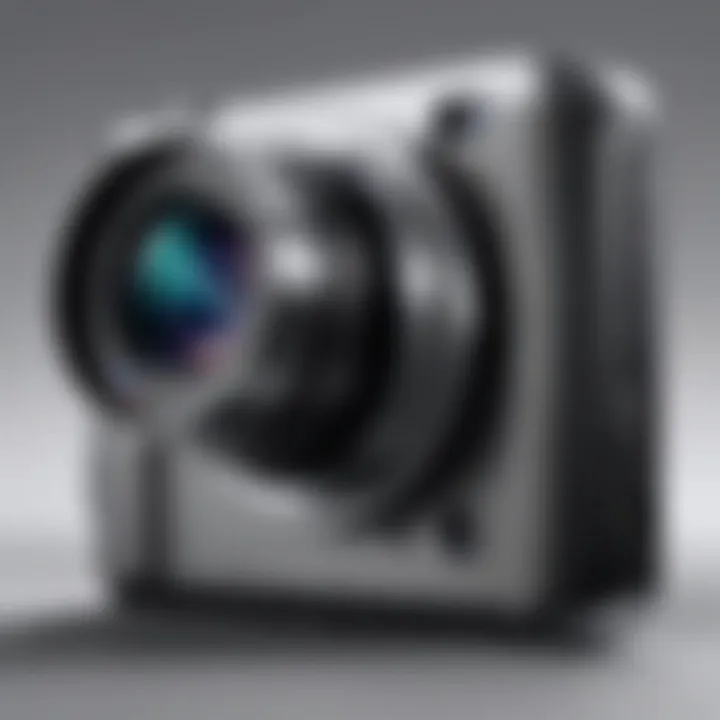Exploring Samsung's Camera Technology: A Study in Innovation


Intro
In today’s world, smartphone cameras play a crucial role in how we capture and share our experiences. As we delve into Samsung's camera technology, it becomes evident that the company has made significant strides in this area. This section will discuss the evolution of Samsung's camera capabilities, emphasizing the pivotal features and technological advancements that set its smartphones apart from competitors.
The importance of camera technology in smartphones cannot be overstated. With users demanding high-quality images and videos for social media and personal use, manufacturers like Samsung are under constant pressure to innovate. This study aims to provide insights into how Samsung has navigated this competitive landscape, enhancing the user experience through thoughtful design and innovative features.
Product Overview
Key Features
Samsung's latest smartphones incorporate several standout features that enhance photography and videography. Some key elements include:
- High-resolution sensors: The use of powerful sensors like the 108MP sensor in the Samsung Galaxy S21 Ultra allows for exceptional detail.
- Night mode: This feature optimizes image quality in low-light conditions, making it easier to capture clear photos at night.
- Ultra-wide and telephoto lenses: Samsung smartphones often feature multiple lenses, such as an ultra-wide lens for expansive landscapes and a telephoto lens for detailed close-ups.
- Advanced software: Samsung’s software algorithms, including AI enhancements, improve image processing, ensuring vibrant colors and sharp details.
Technical Specifications
When examining Samsung's camera technology, it's vital to discuss the technical specifications that make these features possible. Key specifications include:
- Image sensor size: Larger sensors generally capture more light, improving quality in various conditions.
- Aperture size: A wider aperture allows for more light, which is beneficial for low-light photography.
- Optical Image Stabilization (OIS): This reduces blurring caused by shaky hands, especially useful when shooting in suboptimal conditions.
- 4K and 8K video recording capabilities: The option to record in ultra-high-definition formats appeals to content creators and casual users alike, ensuring professional-quality results.
"Samsung continues to lead the market by combining high-quality hardware with innovative software solutions that enhance the user experience."
Performance Analysis
Benchmark Test Results
Performance benchmarking is essential in assessing camera capabilities objectively. Various tests have been conducted to evaluate Samsung's offerings. Factors such as color accuracy, dynamic range, and noise levels at different ISO settings are meticulously analyzed. Test results often reveal that newer models outperform their predecessors, thanks to advancements in sensor technology and processing power.
Real-World Usage Scenarios
Understanding how these features perform in everyday scenarios is crucial. Users have reported remarkable results when photographing landscapes, portraits, and action shots. The versatility provided by multiple lenses allows for creative expression in various settings – be it during family gatherings, nature hikes, or urban explorations.
In summary, Samsung has established itself as a frontrunner in smartphone camera technology, continuously evolving to meet the needs of consumers. The combination of top-tier hardware and intelligent software creates an appealing package for both casual users and professionals.
Samsung's Position in the Smartphone Market
Samsung has established itself as a formidable force in the global smartphone market. Its position is particularly significant when analyzing the company's advancements in camera technology. Understanding Samsung's market standing provides vital context for discussing its innovations. The brand's extensive reach, modern design language, and commitment to quality act as key components contributing to its influence. Thus, examining Samsung's position requires a deeper insight into its historical success, current strategies, and vision for the future.
Historical Overview
Samsung's journey in the smartphone sector began over a decade back. Initially, the company focused on feature phones, leveraging its extensive electronics background. The introduction of the Samsung Galaxy series in 2010 marked a pivotal shift. This series combined cutting-edge hardware with a user-friendly interface, leading to rapid growth in market share.
By continually refining its offerings, Samsung maintained its reputation as a leader in innovation. Key strategies included the incorporation of high-quality displays, advanced processing power, and, importantly, superior camera systems. Through various iterations, from the Galaxy S series to the Note series, Samsung emphasized its camera technology as a differentiating factor, catering to both casual users and professional photographers.
Current Market Trends
In the current smartphone landscape, competition is fierce. Brands such as Apple, Google, and Huawei are also fighting for market supremacy. However, Samsung remains at the forefront due to several critical trends. One significant trend is the growing demand for high-quality camera capabilities in smartphones. Users today prioritize camera features, leading Samsung to innovate continually.
Another trend is the increasing importance of computational photography. Samsung has embraced this shift, integrating software enhancements that improve image quality and provide users with versatile shooting modes. Features like Super Steady video stabilization and Night Mode highlight the company's commitment to enhancing user experience. Additionally, the rise of social media and content creation has solidified Samsung's position in the market, as high-performing cameras are essential for users eager to share their experiences.
In summary, Samsung's historical success and responsiveness to current market trends solidify its standing in the smartphone arena. The emphasis on camera technology has not only shaped Samsung's identity but also continues to influence user expectations and industry standards.


Camera Technology Evolution
The evolution of camera technology is a vital subject in understanding how Samsung has positioned itself in the competitive smartphone market. This section focuses on the specific milestones and advancements that have marked significant improvements in the quality and functionality of smartphone cameras. The journey from basic camera features to sophisticated imaging systems not only reflects Samsung's innovative spirit but also demonstrates the shift in consumer expectations surrounding mobile photography.
Advancements in camera technology lead to better user experiences. Improved cameras impact daily life and professional activities by allowing users to easily capture high-quality images. The rise of social media, for instance, underscores the demand for superior camera capabilities. As mobile photography continues to gain popularity, it is critical to assess how Samsung addresses these trends through its ongoing innovations.
Key Milestones in Camera Development
Samsung's journey in camera development is marked by several key milestones. One notable advancement was the introduction of the 12-megapixel camera in the Galaxy S5. This was a game-changer, combining higher resolution with enhanced low-light performance. Furthermore, the development of dual-camera systems in later models, like the Galaxy Note 8, allowed for more versatile photography, including the ability to create better depth-of-field effects.
Another significant milestone was the introduction of the ISOCELL technology. This innovation improved light intake, enhancing the overall image quality, especially in low-light conditions. The ISOCELL sensors have become a standard feature in many of Samsung's flagship models, highlighting the company's commitment to pushing the boundaries of smartphone camera technology.
Innovations in Lens Design
Lens design is critical in determining the performance of camera systems. Samsung has incorporated various innovations in its lens designs to enhance the user experience. The introduction of wider apertures allows for more light to enter the camera, which is particularly important in challenging lighting conditions.
Samsung has also experimented with multi-lens setups. By integrating telephoto and ultra-wide lenses, they give users more creative options. This design approach caters to different photographic needs, making it easier to capture the desired shot for any occasion.
Additionally, the use of optical image stabilization (OIS) within their lens systems reduces blur in photos, improving the clarity and overall quality of images, especially in low-light settings or during motion.
Sensor Advancements
The sensor is one of the most critical components of any camera system. Samsung’s focus on sensor advancements has been a primary driver of its camera technology evolution. The implementation of larger sensors in the latest models increases the capacity to capture more light, leading to significant improvements in photo quality.
One of the most noteworthy advancements is the use of the 108-megapixel sensor in models like the Galaxy S20 Ultra. This level of resolution enables users to take impressive high-quality images without losing detail. Furthermore, the sensor's technology allows for pixel binning, which combines data from multiple pixels to improve image quality, especially in low-light environments.
"Sensor technology has significantly changed how we approach photography, making high-quality images accessible to the average user."
In summary, the evolution of camera technology at Samsung illustrates a committed approach to innovation. Key milestones, lens design enhancements, and sensor advancements all contribute to an advanced photographic experience for users. These developments not only elevate Samsung's products in the eyes of consumers but also contribute to a broader trend of increasing reliance on smartphone photography in everyday life.
Analyzing Samsung's Camera Features
Analyzing Samsung's camera features is crucial for understanding how the brand has positioned itself within the competitive smartphone market. The effectiveness of a smartphone's camera system significantly influences user experience. From amateur to professional photographers, the quality of images and videos are often the deciding factors for consumers when selecting a device. Samsung invests heavily in research and development to enhance its camera capabilities. Features such as pixel count, zoom functionality, low-light performance, and video capabilities are pivotal elements that merit in-depth examination.
Pixel Count and Resolution
Samsung's approach to pixel count is one of the distinguishing characteristics of its smartphone cameras. Generally, higher pixel counts lead to more detail in images. Samsung's flagship models often feature cameras with resolutions of 108 megapixels or higher. This leap in resolution allows for greater cropping flexibility during editing without sacrificing image quality.
In addition, higher resolution translates to larger file sizes, which can impact storage. Users should balance the need for detail against storage capacity. The image processing algorithms further refine these high-resolution images, often employing AI to enhance clarity and detail. This fusion of hardware and software provides a powerful tool for capturing stunning photographs.
Optical and Digital Zoom
Samsung's innovations in zoom technology define its camera offerings as well. Optical zoom operates by utilizing the camera's lens to magnify the subject without sacrificing quality. Samsung often integrates periscope lenses in models like the Galaxy S series, achieving impressive optical zoom levels—up to 10x or more in some instances. This capability is particularly valuable for wildlife photography or distant shots where preserving image quality is critical.
Digital zoom, however, is more common and often misrepresented. It enlarges the image through software, which can result in quality loss. Samsung's software attempts to mitigate this downside through advanced algorithms that enhance clarity, but true optical zoom remains superior. Consumers should assess their photography habits to determine whether they need extensive zoom capacity, as this affects decisions on model selection.
Low Light Performance
Capturing images in low-light conditions remains a challenge for many smartphones. Samsung has made strides in improving this aspect of its camera technology. Many recent models are equipped with advanced sensors that can capture more light. This enhancement helps reduce graininess and improve detail. The incorporation of larger sensor sizes and wider apertures contributes to superior low-light performance.
Samsung's software often employs multi-frame processing techniques. This involves taking several images in quick succession and combining them to enhance overall brightness and detail. For users who often take photographs at nighttime or in dimly lit settings, these capabilities are indispensable. Selection of a Samsung model with robust low-light performance can significantly improve the quality of nighttime photography.
Video Capabilities


Samsung smartphones are not limited to still photography; their video capabilities are equally impressive. Most recent models support 4K video recording, while some flagship models even offer 8K recording capabilities. This resolution provides unprecedented detail, especially valuable for those looking to create high-quality video content.
Additionally, features like Super Steady stabilization minimize shakiness, making handheld shooting achievable even at high resolutions. Samsung also integrates various shooting modes, such as slow motion and hyper-lapse, offering users creative flexibility. This wide array of options positions Samsung's video functionalities as a compelling choice for those interested in videography alongside photography.
"Samsung continually enhances its camera features to meet the demands of tech-savvy consumers, offering versatile and powerful tools for both photography and videography."
Performance Benchmarks of Samsung Camera Phones
Performance benchmarks serve as a vital tool for understanding the capabilities of Samsung's camera phones. They are essential not only for consumers but also for tech enthusiasts and professionals who wish to grasp the finer details behind specifications and actual performance in real-world usage.
These benchmarks provide insights into how cameras perform under various conditions, revealing strengths and weaknesses in different environments and applications. For instance, testing often involves low-light performance, image stabilization, and autofocus speed. Such metrics allow users to make informed choices, whether they are amateur photographers or professional content creators.
Real-world Testing Scenarios
Real-world testing scenarios uniquely highlight the performance of Samsung's camera phones. Evaluating cameras in predictable lab conditions is helpful, yet it does not present a complete picture. Users often encounter differing lighting, motion, and subject complexity in everyday situations.
Testing typically includes:
- Low Light Testing: Samsung's latest models like the Galaxy S23 Ultra are put through their paces during low-light conditions to measure noise levels, detail preservation, and color fidelity.
- Action Shots: Capturing fast-moving subjects provides insights into the camera's autofocus system and shutter lag. This is critical for sports and wildlife photography.
- Portraits: Assessing how cameras handle depth of field effects and skin tones helps illustrate their capability in well-lit environments.
Each scenario plays a role in illustrating how Samsung's technology adapts to different requirements, guiding users based on their photographic needs.
Comparative Analysis with Competitors
In the highly competitive landscape of smartphone cameras, comparing Samsung's offerings with those from rivals is necessary. Each brand touts unique features and technologies. Notably, several factors come into play during this analysis:
- Image Quality: Evaluating the sharpness, contrast, and color accuracy for models from Apple, Google, and others helps set a standard.
- Feature Sets: Samsung offers unique features like Space Zoom and Super Steady video recording. Understanding how these features compare to Apple’s ProRAW and Google’s computational photography is essential.
- User Feedback: Customer reviews can provide practical insights, noting experiences beyond technical specifications. Positive feedback about Samsung's camera UI may contrast with critiques from users of other brands.
In drawing these comparisons, it becomes evident where Samsung excels and where improvements may be necessary. Overall, these benchmarks and comparisons serve to deepen the understanding of Samsung's approach to camera technology.
User Experience and Camera Integration
In today’s smartphone marketplace, the user experience is a critical component of how devices, especially those with advanced camera technology, are perceived and adopted. Samsung, recognized for its significant contributions to mobile photography, emphasizes effective camera integration within its smartphones. This integration enhances the usability and functionality of the camera, ensuring that users can capture high-quality images with minimal effort.
Ease of Use
The ease of use is paramount for users who wish to exploit their smartphone's camera capabilities fully. Samsung smartphones typically feature intuitive interfaces that allow users to navigate through various camera modes and options without feeling overwhelmed. The design of the camera app is straightforward, providing quick access to functions like shooting modes, filters, and settings. Users can capture photos with a simple tap, which is essential for spontaneous moments.
Moreover, tutorials often accompany new features, guiding users in utilizing advanced capabilities. This focus on user-friendliness serves not only casual photographers but also more experienced users looking for control over their shots. Samsung also prioritizes accessibility features, allowing individuals with different needs to effectively use the camera.
Software Enhancements
Software plays a crucial role in enhancing the camera experience on Samsung devices. Through software updates, Samsung has added features that significantly improve both image quality and usability. For instance, tools for night photography, portrait mode adjustments, and AI-driven suggestions help users achieve desired results.
One significant enhancement in recent models is the incorporation of artificial intelligence within the camera software. This AI assists in scene recognition, automatically adjusting settings to optimize photo quality based on the environment. Such features are especially attractive to users who may not possess advanced photographic skills but still wish to capture impressive images.
Additionally, Samsung integrates social media sharing options directly into their camera software. This allows users to post their photos on platforms like Facebook and Reddit with minimal steps, enhancing the overall experience.
"The integration of software features not only enhances user creatives but also streamlines the photography process for all users."
By regularly updating their camera software, Samsung keeps its users engaged and encourages them to explore new capabilities. This blend of ease of use and powerful software enhancements solidifies Samsung's position as a leading manufacturer in smartphone camera technology.


Impact of Camera Technology on Photography
The impact of camera technology on photography is profound and multifaceted. In recent years, advancements in camera capabilities have reshaped how photographs are taken, shared, and perceived. These innovations are not just incremental improvements; they represent a seismic shift in the way we engage with the art of photography.
One of the most significant elements of this impact is the transition from traditional cameras to smartphones equipped with high-quality cameras. This shift has democratized photography, making it accessible to a broader audience. The convenience of carrying a smartphone means that moments can be captured spontaneously, leading to an increase in the quantity and diversity of photographs taken.
Shifts in Photography Practices
This new era of camera technology has led to notable shifts in photography practices. Photographers, both amateur and professional, have embraced mobile devices as viable alternatives to DSLRs. Features such as multiple lenses, enhanced editing capabilities, and instant sharing platforms have changed how we approach photography. Photographers often prefer working with smartphones due to their portability and continuous enhancements in software that allow for advanced editing on the go.
Key shifts in practices include:
- Spontaneity and Accessibility: Smartphones enable users to capture moments without the need for heavy equipment.
- Focus on Composition: With ease of access, individuals are more likely to experiment and improve their composition skills.
- Social Sharing: Platforms like Instagram and Facebook have created a new audience for photographers, enhancing the importance of sharing visual content.
The Rise of Mobile Photography
The rise of mobile photography reflects how significantly camera technology has impacted photographic practices. It presents new opportunities for both creativity and professional development. The integration of powerful editing software into mobile devices allows for a comprehensive creative process, from capture to sharing.
Emerging trends show that individuals are prioritizing quality over quantity. Many are now dedicated to mastering skills such as light manipulation, framing, and digital post-processing, shaping an entirely new sub-culture within photography.
Factors contributing to this rise include:
- Social Media Influence: The desire for social recognition fosters a culture of high-quality content.
- Technological Advancements: With brands like Samsung leading the way in camera innovations, the quality of mobile photography has reached impressive levels.
- Education Resources: Online tutorials and communities allow users to learn skills more efficiently than ever before.
Future Directions for Samsung's Camera Innovations
The future of Samsung's camera innovations plays a critical role in shaping how we engage with mobile photography. As smartphone usage continues to expand across diverse demographics, Samsung's ability to adapt and innovate its camera technology will impact user experience and competitive positioning.
Emerging trends such as artificial intelligence, machine learning, and computational photography are reshaping expectations regarding image clarity, color accuracy, and user-friendly interfaces. Moreover, the increasing demand for content creation, especially through platforms like Instagram and TikTok, makes it essential for Samsung to focus on high-performance camera systems that cater to this growing market.
In this section, we will explore emerging technologies and predictions for future releases, highlighting their implications for both average users and technology professionals.
Emerging Technologies
Emerging technologies are set to revolutionize the landscape of mobile photography. Several key areas warrant attention:
- AI-Driven Enhancements: Samsung is investing heavily in AI to automate image adjustments, recognize scenes, and optimize aspects like exposure and focus. Custom algorithms can enable users to achieve professional-quality images without extensive knowledge of photography.
- Advanced Optical Systems: New developments in lens technology are likely to enhance zoom capabilities, allowing for clear shots even at significant distances. Innovations may include periscope lenses or new types of glass that reduce distortion and enhance sharpness.
- Improved Sensors: Future camera phones may utilize larger sensors with better low-light performance. This can enhance photography in challenging environments, improving user satisfaction.
- Augmented Reality: Future models may integrate AR features, allowing users to visualize photography outcomes before capturing an image. This can provide a unique interactive experience that supports creativity.
Predictions for Future Releases
Looking ahead, several predictions can be made regarding Samsung's future camera releases:
- Greater Integration of AI Features: Enhanced AI capabilities to streamline photography processes, minimizing the need for manual adjustments. This will empower users of all skill levels to capture stunning images effortlessly.
- Multi-Camera Configurations: Expect to see more models featuring multiple cameras with specialized functions, such as macro, ultra-wide, and depth sensors, allowing for versatile photography styles.
- Sustainability Focus: Future releases may emphasize sustainability, incorporating eco-friendly materials and energy-efficient components, which resonate with growing consumer awareness.
- User-Centric Design: Improvements in the user interface are anticipated, ensuring that accessing advanced camera features is intuitive and seamless.
"Innovations in camera technology are not just about adding features; they’re about enhancing the user experience and enabling creativity on-the-go."
End
The conclusion of this article serves to highlight the significance of Samsung’s camera technology advancements and their implications for consumers and professionals alike. It brings to light how Samsung’s innovations have redefined mobile photography, engaging users by providing powerful tools that were once limited to professional equipment. Evaluating these elements helps in understanding not only the technology itself but also its relevance in various contexts of modern life.
Final Thoughts on Samsung's Camera Phones
Samsung’s camera phones represent a blend of convenience and high-quality photography. The combination of advanced hardware and intuitive software puts creative power in the hands of users at every level. High pixel counts, exceptional low-light capabilities, and features like Super Steady video stabilization set Samsung apart in the competitive smartphone market. Photographers can now anticipate that a Samsung device may meet, or even exceed, their expectations for capturing stunning images.
"Samsung has continuously pushed the envelope, redefining what is possible with smartphone cameras."
Moreover, the integration of artificial intelligence in Samsung's camera systems allows for real-time optimization and editing. This not only enhances the user experience but also caters to a wider audience—from casual users to photography enthusiasts. Understanding these innovations provides essential insight into the future landscape of mobile photography and its impact on personal and professional practices.
Choosing the Right Samsung Model for Photography Needs
Selecting the most suitable Samsung model requires careful consideration of intended use. Here are some key points to consider:
- Camera Specifications: Look closely at the specifications such as megapixel count, aperture sizes, and optical zoom capabilities. Devices like the Samsung Galaxy S series excel in advanced features, while the A series offers solid performance at a more affordable price.
- User Preferences: Think about what kinds of photos you wish to capture. For night photography, models with larger apertures and superior low-light performance, like the Samsung Galaxy S21 Ultra, are advisable. If you primarily shoot outdoors, a high dynamic range and superior zoom may be more beneficial.
- Budget Considerations: Samsung offers a range from high-end devices to more budget-friendly options. Determine how much you are willing to invest based on your photography needs.



